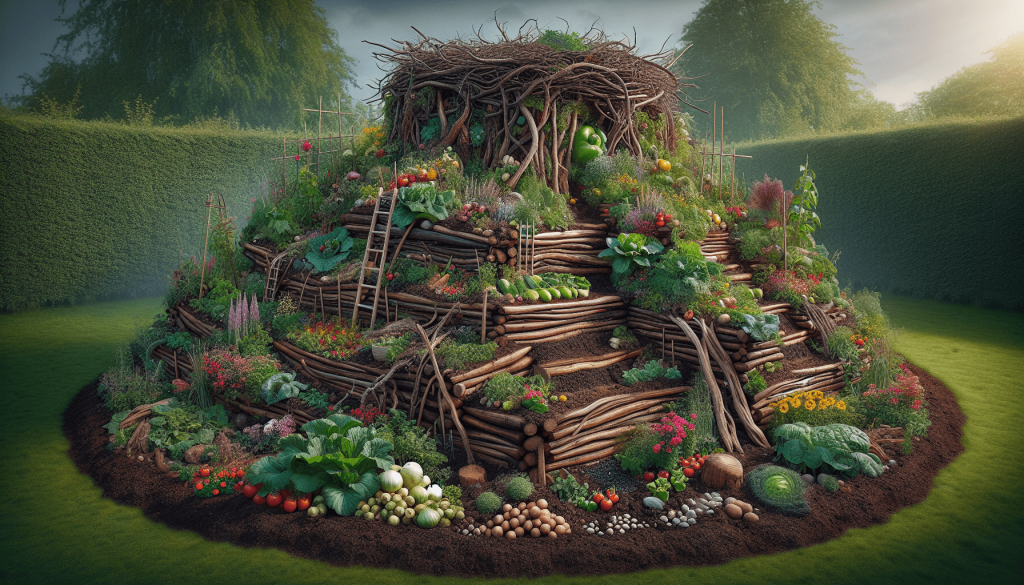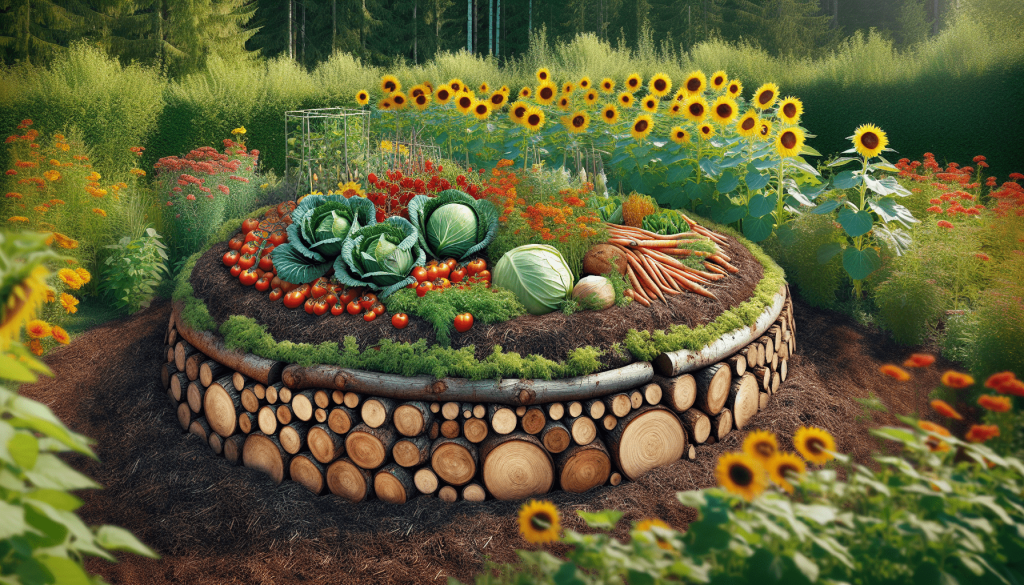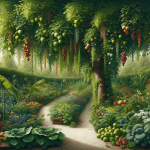This post may contain affiliate links. As an Amazon Associate, we may earn commissions from qualifying purchases.
Have you ever dreamed of having a lush, thriving garden that’s easy to maintain and sustainable? In “What Are The Steps To Building And Maintaining A Hügelkultur Bed?”, you’ll discover an eco-friendly gardening method that mimics the natural nutrient cycles of a forest floor. This article walks you through each step of creating your own hügelkultur bed, from selecting the right materials and layering them effectively, to ensuring the ongoing health and productivity of your garden. You’ll learn how to transform woody debris and organic waste into a rich, fertile growing space that not only looks beautiful but also conserves water and nurtures your plants for years to come. Ever wondered how you could turn heaps of organic waste into something beneficial for your garden? If you have, you’re in for a treat with the concept of Hügelkultur. This age-old gardening technique hails from Germany and involves building mounds filled with wood and other organic material, resulting in raised garden beds that can significantly boost soil fertility and water retention. So, how do you go about building and maintaining a Hügelkultur bed? Let’s dive into the steps and details.
Understanding Hügelkultur
What is Hügelkultur?
Hügelkultur, which translates to “hill culture,” is a form of raised bed that is built using various types of organic material layered in a specific manner. The process is centered around the idea of imitating the natural decomposition of wood and organic matter in a forest floor. The core of a Hügelkultur bed is wood, which breaks down slowly over time, creating a hospitable environment for plant roots.
Benefits of Hügelkultur
Before we start building, it’s important to understand why you might want to consider this method for your garden. Here are some key benefits:
- Improved Soil Fertility: As the wood and organic matter decompose, they enrich the soil with nutrients.
- Water Retention: The wood acts like a sponge, soaking up water and releasing it slowly over time, reducing the need for frequent watering.
- Soil Aeration: The decomposition process creates pockets of air, enhancing soil structure and root development.
- Sustainable Waste Management: Hügelkultur beds allow you to recycle garden waste and fallen branches rather than sending them to landfill.
Steps to Build a Hügelkultur Bed
Step 1: Choose a Location
The first step in building your Hügelkultur bed is to select an appropriate location. Ideally, pick a spot that gets ample sunlight but is also accessible for watering and maintenance.
Step 2: Gather Materials
You’ll need various types of organic material to build your Hügelkultur bed. Here’s a quick checklist:
| Material Type | Examples |
|---|---|
| Woody Material | Logs, branches, twigs |
| Green Material | Grass clippings, kitchen scraps, leaves |
| Soil | Garden soil or compost |
| Optional Amendments | Manure, bone meal, or other fertilizers |
Step 3: Prepare the Site
Start by marking the area where your bed will go. Dig a trench about a foot deep. This trench will serve as the foundation for your woody material.
Step 4: Lay the Foundation
Begin with the largest and thickest logs at the bottom of the trench. This will form the core of your Hügelkultur bed. Stack the wood in a haphazard manner to create air pockets, which will aid in decomposition.
Step 5: Add Green Material
Add a layer of green material like grass clippings, kitchen scraps, or leaves over the wood. This layer will kickstart the decomposition process by providing the necessary nitrogen.
Step 6: Cover with Soil
Now, cover the layers of wood and green material with a generous amount of soil or compost. This will provide the medium needed for planting and will also help retain moisture.
Step 7: Optional Amendments
If you have any additional soil amendments like manure or bone meal, now is the time to add them. This helps to boost the nutrient content of your Hügelkultur bed.
Step 8: Water Thoroughly
After constructing your bed, water it thoroughly. This will help settle the materials and kickstart the decomposition process.
Step 9: Plant Your Vegetables or Flowers
Finally, it’s time to plant! You can plant immediately, but keep in mind that a newly constructed Hügelkultur bed might be more fertile after a few weeks to months of settling and initial decomposition.

Maintaining Your Hügelkultur Bed
Regular Watering
Though Hügelkultur beds are excellent for water retention, they still need regular watering, especially during the initial stages. Check the moisture level regularly by sticking your finger a few inches into the soil. If it feels dry, it’s time to water.
Replenishing Organic Material
Over time, the layers of organic material in your Hügelkultur bed will break down. You might need to add new material every year or so to maintain the structure and fertility of the bed. Simply layer new organic materials on top and cover with a fresh layer of soil.
Weed Control
Weeds can be a nuisance in any garden, and Hügelkultur beds are no exception. Regularly check for weeds and remove them promptly to ensure they don’t compete with your plants for nutrients and water.
Monitoring Soil Health
Keep an eye on the health of your soil. You might need to add additional compost or organic fertilizers if you notice a decline in plant health or productivity.
Pest Management
Hügelkultur beds can attract beneficial insects, but you might also find yourself dealing with pests. Practice organic pest management techniques like using neem oil or introducing beneficial insects like ladybugs to keep the pest population in check.
Adjusting Plant Varieties
Different plants have different nutrient and water requirements. Experiment with various plants to see which ones thrive best in your Hügelkultur bed. Rotate crops yearly to prevent soil depletion and improve biodiversity.
FAQs About Hügelkultur
How Long Does a Hügelkultur Bed Last?
A well-built Hügelkultur bed can last for up to 6 years or more, depending on the materials used and the climate. The bed will gradually settle as the organic material breaks down, so you might need to replenish the layers every few years.
Can I Build a Hügelkultur Bed in Any Climate?
Hügelkultur beds can be built in various climates, but they are particularly effective in areas with moderate to heavy rainfall due to their water-retentive properties. In very dry climates, additional watering might be necessary to maintain plant health.
What Size Should My Hügelkultur Bed Be?
There’s no strict rule for the size of a Hügelkultur bed. However, a common size is about 3-4 feet wide and as long as you desire. The height can vary, but a height of 1-2 feet is common for ease of planting and maintenance.
Can I Build a Hügelkultur Bed on a Slope?
Yes, Hügelkultur beds can be built on a slope. In fact, building on a slope can aid in natural drainage and water retention. Ensure the bed is stable and well-supported to prevent erosion.

Conclusion
Building and maintaining a Hügelkultur bed can seem like a daunting task, but the rewards are well worth the effort. Not only will you be turning waste into a valuable resource, but you’ll also be creating a sustainable, fertile environment for your plants. Remember, the key to a successful Hügelkultur bed lies in the careful selection of materials, regular maintenance, and a bit of patience.
So, why not give it a try? Armed with this guide, you’re ready to start building your very own Hügelkultur bed. Happy gardening!








